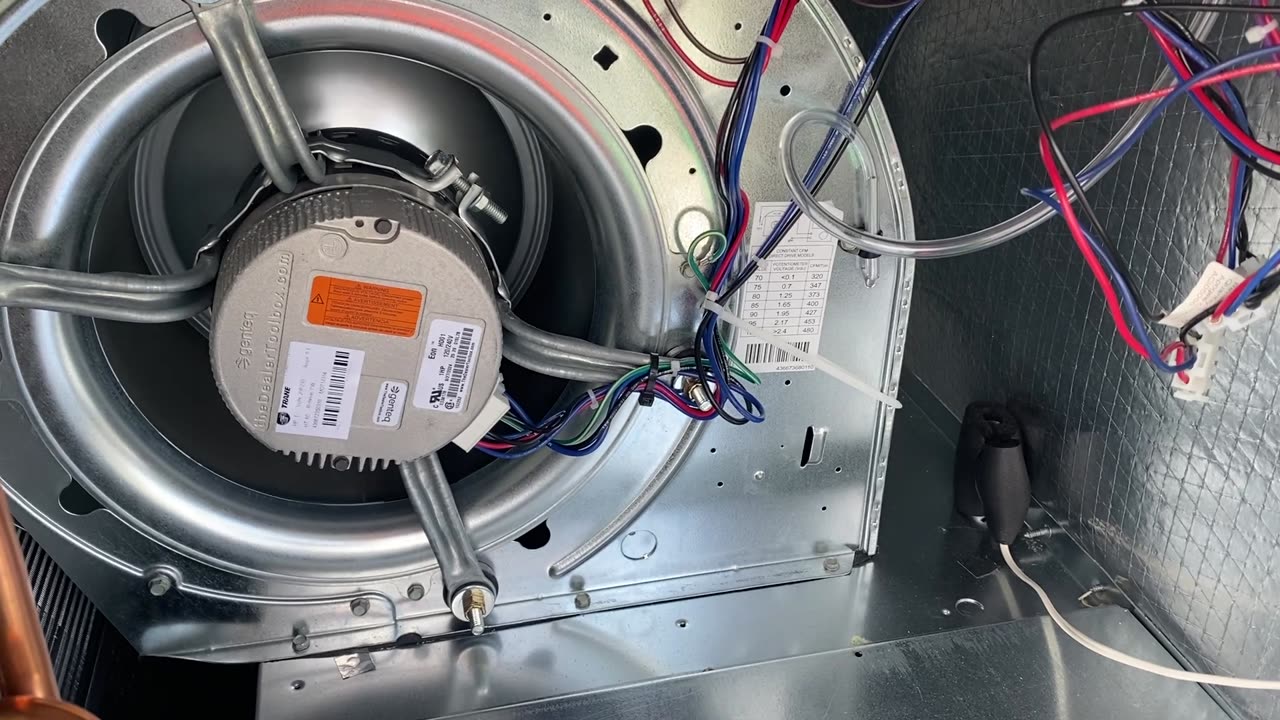Premium Only Content

Find CFM on an RTU First
Sorry for the noise.
NOTE: One thing that may have been misleading, the MERV rating of the air filter does not change the TESP reading. It changes the CFM calculation on the chart when the chart CFM rating considers a standard air filter and not a higher MERV rated air filter. I believe Trane considers a MERV 8 to be “standard”, but many customers opt for MERV 11 or even 13.
Three ways to find actual CFM on a Trane RTU. Today, we’re looking at a Trane Precedent unit.
Total External Static Pressure (TESP) on an RTU is measured by reading Return Air Static Pressure before the air filters with MERV 8 standard pleated filters and Discharge Air Static Pressure after the heat exchanger. Pull up the IOM or manufacturer literature and plot that against the Brake Horsepower and/or RPM. (Calculate BHP using Measured Current / FLA * Blower Motor Rated HP.)
Additionally, you can calculate actual CFM using the Temperature Rise Method. I would recommend using the tools at your disposal and search for a CFM Temperature Rise BTU calculator. All you should have to do is plug in two variables to get the third. If you plug in Temp Rise and BTUH Output (not Input), then you’ll get CFM. If you plug in CFM and BTUH Output (located on the Data Tag), then you’ll get the Temp Rise. NOTE: The temperature rise calculation only works when there is no change in latent heat (no change in humidity, only “Sensible Heat”). If you change humidity (as in cooling, dehumidification, reheat, or humidification processes), you have to use a different calculation.
ALWAYS VERIFY AIRFLOW (CFM) FIRST when troubleshooting.
1) AIRFLOW (Indoor Coil and Outdoor Coil)
2) ELECTRON FLOW
3) REFRIGERANT, WATER, GLYCOL, STEAM, PROPANE, and NATURAL GAS FLOW
4) If you connect your gauges before measuring airflow, you get one demerit.
-
 LIVE
LIVE
Quite Frankly
5 hours ago"State of Union, Good Medicine, Judge Caprio" ft G Edward Griffin 8/21/25
400 watching -
 1:19:21
1:19:21
The Shannon Joy Show
8 hours ago🔥🔥The One & Done Kill Shot? New ‘Universal Vaccine’ & Complete Inversion As Peter Hotez WARNS Of Adverse Injury While RFK Promotes! 🔥🔥
4.06K15 -
 1:10:29
1:10:29
TheCrucible
2 hours agoThe Extravaganza! Ep. 25 (8/21/25)
50K4 -
 40:20
40:20
The White House
2 hours agoPresident Trump Joins Law Enforcement and Military Personnel in Washington, D.C.
12.6K16 -
 1:22:25
1:22:25
Kim Iversen
20 hours agoPsychic Medium Blows Lid Off "Interdimensional Beings" | Evil Spirits or Psyop?
37.8K47 -
 1:04:35
1:04:35
The Officer Tatum
3 hours agoLIVE: Trump SAVES DC, Letitia James Fine THROWN OUT + MORE | EP 160
13.2K12 -
 1:58:01
1:58:01
Redacted News
3 hours agoHIGH ALERT! Netanyahu Calls for Mass Censorship as Israel Prepares MASSIVE Invasion of Gaza City
85.9K47 -
 36:03
36:03
Kimberly Guilfoyle
4 hours agoA New Day in DC: Appeals Court Throws Out Witch Hunt Case, Live! | Ep248
24K10 -
 1:13:59
1:13:59
vivafrei
5 hours agoBig Tish Gets SPANKED! Appeal Court ANNULS $500 Million! Corruption at the FED? Trans Madness & MORE
95.4K27 -
 1:53:59
1:53:59
The Quartering
5 hours agoToday's Breaking News!
83.1K17